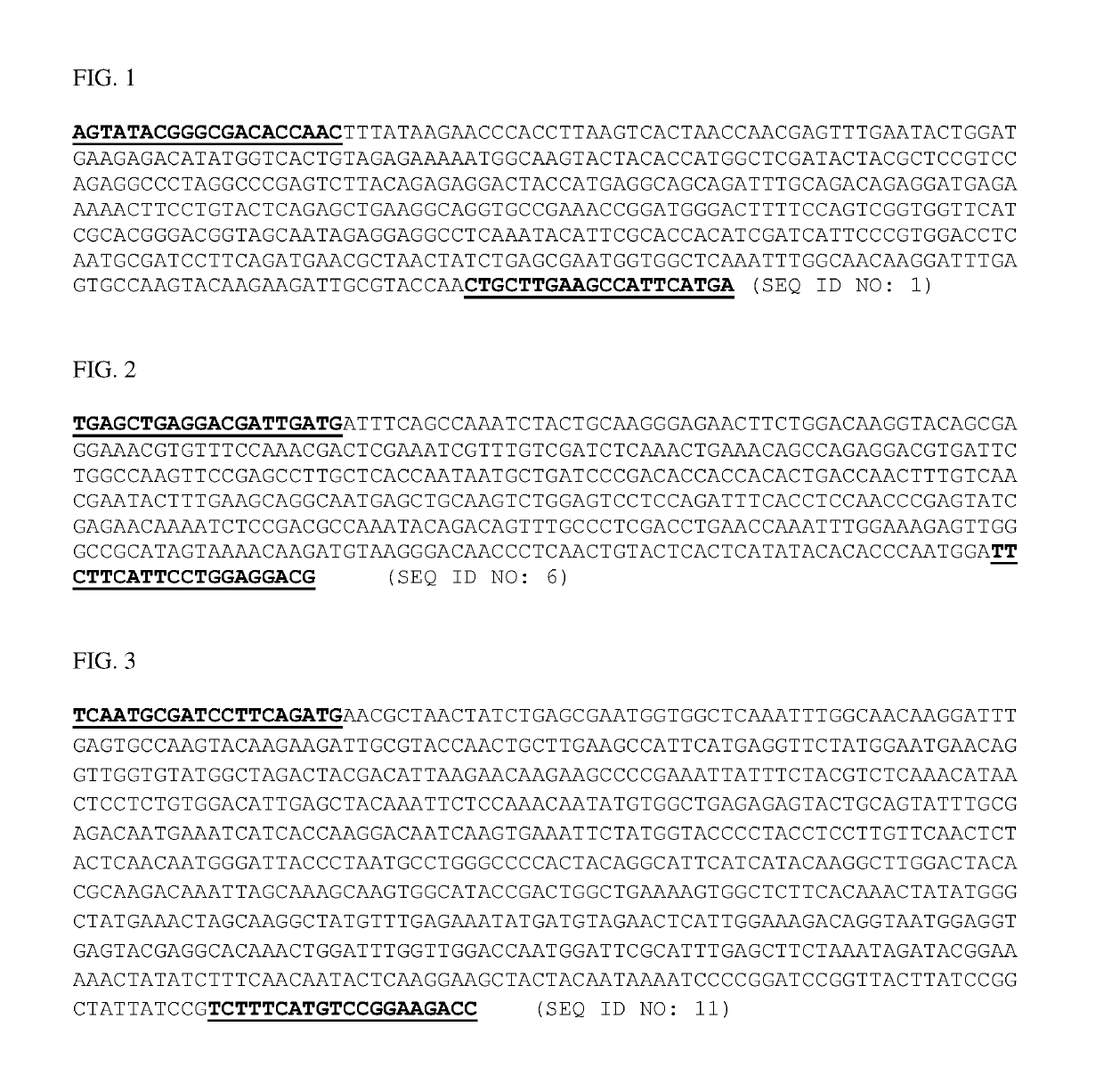Double stranded RNA compositions for reducing asian citrus psyllid infestation and methods of use
a technology of psyllids and compositions, applied in the field of double stranded rna, can solve the problems of reducing the corresponding protein that would have been made from the targeted and degraded rna, especially devastating to the u.s. and florida citrus industries, and reducing the survival rate of d, so as to reduce the fitness and increase the mortality
- Summary
- Abstract
- Description
- Claims
- Application Information
AI Technical Summary
Benefits of technology
Problems solved by technology
Method used
Image
Examples
example 1
Selection of Sequence and Production of dsRNA
[0078]D. citri trehalase sequence was obtained by automated computational analysis from a D. citri genomic sequence (GenBank NW_007377674.1), annotated using gene prediction method: Gnomon. Supporting evidence includes similarity to: 16 Proteins, and 100% coverage of the annotated genomic feature by RNAseq alignments, including 5 samples with support for all annotated introns. All sequences annotated as trehalase in the transcriptomic library were selected, aligned in order to check for possible sequencing errors, and finally the correct sequence was identified. The final sequence was submitted to another round of comparative analysis, which included: (1) sequencing and comparative analysis of nucleotide sequence using BLAST® analyses tools (NCBI website, blast.ncbi.nlm.nih.gov / Blast.cgi) to confirm that the sequence is from trehalase; (2) in silico translation to find the putative trehalase protein amino acid sequence; (3) followed by co...
example 2
Psyllid RNAi Feeding Bioassay-cuttings
[0086]In general, the RNAi feeding bioassay using plant cuttings has the following protocol. In citrus, the “flush”, which are new foliar shoots growth, were collected from potted citrus seedlings grown in a glasshouse to produce small cuttings. The flush are about 7-8 cm long. The plant flush was washed in 0.2% bleach water, for 10 min. Then the base of each stem of each flush was cut at a 45 degree angle while submerged in filtered water. The flush was then placed into a 1.5 mL tube containing 0.5 mL water. A dsRNA solution (100 ng of dsRNA in 300 μL of water) was added to the water in the tube, the tube top was wrapped with plastic or Parafilm™ (Bemis NA, Neenah, Wis.) and placed under artificial lighting to stimulate absorption of the dsRNA solution. After the flush absorbs the entire dsRNA solution (approximately 8 hours), the tube was filled with water using a 26 gauge syringe needle and syringed filtered (0.45 μ). The treated cuttings wer...
example 3
Psyllid RNAi Feeding Bioassay—Seedling
[0093]Sweet orange seedlings were cultivated in plastic containers (2 gallon pots) containing potting soil and maintained in a glasshouse. Seedlings about 30 cm or 12 inches tall were trimmed, removing all branches, leaving just the seedling trunk. When the seedling produced new growth two weeks post-trimming, 20 adult female D. citri were caged on each plant, so they could oviposit eggs for 48 hours. The adults were then removed, and 10 μg of trehalase dsRNA (based on SEQ ID NO: 1) was mixed with 10 mL of water, and the dsRNA solution was poured onto the soil. Seedlings were watered as needed post-treatment. Three sweet orange seedlings were treated with dsRNA based on SEQ ID NO: 1 (treatment #1), and three sweet orange seedlings received just 10 mL of water (treatment #2, negative control). All three seedlings from each treatment group were caged together in a Bug Dorm 2 rearing cage, catalog #1462W (BioQuip, Rancho Dominguez, Calif.). The pla...
PUM
| Property | Measurement | Unit |
|---|---|---|
| angle | aaaaa | aaaaa |
| temperature | aaaaa | aaaaa |
| temperature | aaaaa | aaaaa |
Abstract
Description
Claims
Application Information
 Login to View More
Login to View More - R&D
- Intellectual Property
- Life Sciences
- Materials
- Tech Scout
- Unparalleled Data Quality
- Higher Quality Content
- 60% Fewer Hallucinations
Browse by: Latest US Patents, China's latest patents, Technical Efficacy Thesaurus, Application Domain, Technology Topic, Popular Technical Reports.
© 2025 PatSnap. All rights reserved.Legal|Privacy policy|Modern Slavery Act Transparency Statement|Sitemap|About US| Contact US: help@patsnap.com

